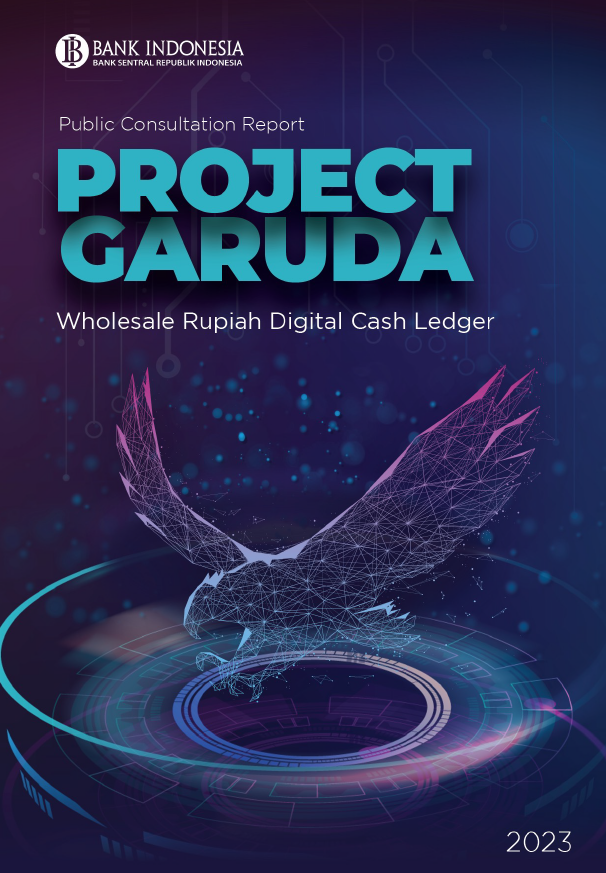Project Garuda is an initiative which encompasses the endeavors in exploring the optimal design for Indonesian CBDC, or Rupiah Digital. Rupiah Digital is a contribution brought by Bank Indonesia to the nation in a struggle to safeguard the sovereignty of Rupiah in the digital era.
The project reinforces Bank Indonesia's preceding initiatives in advancing digital transformation of the country, particularly with the mutual objective of accomplishing an end-to-end integration of economy and finance, which has been promoted through the Indonesian Payment System Blueprint 2025 (BSPI 2025) and Blueprint for Money Market Development 2025 (BPPU 2025).
As a first step, Bank Indonesia issued a white paper concerning the development of Rupiah Digital on 30 November 2022. The White Paper elaborated the high-level design for Rupiah Digital under the hood of Project Garuda as well as initiated public communication regarding the development plan of Rupiah Digital.
This White Paper elucidated: (i) Rupiah Digital end-to-end integrated design configuration, (ii) Rupiah Digital design features that would stimulate new business models, (iii) Rupiah Digital technology architecture, as well as (iv) regulatory and policy supports for the implementation of the Rupiah Digital design.
Considering its extensive implications, this national-scale initiative requires synergistic efforts in its formulation and implementation. Similarly, the synergy with the international central banking community and international organizations is essential to ensure the alignment of the Rupiah Digital design with various interoperability initiatives for cross-border transactions.
Bank Indonesia issued the Stage I
Consultative Paper titled "Project Garuda: Wholesale Rupiah Digital Cash Ledger" on January 31, 2023, following the release of the Project Garuda White Paper.
The
Consultative Paper aims to gather input and feedback from stakeholders (public-private collaboration) on the design, impact, and benefits of Rupiah Digital to ensure it meets current and future needs.
This paper outlines the development design for the
Rupiah Digital at the
immediate state, focusing on the wholesale
Rupiah Digital Cash Ledger. It includes the introduction of technology and basic functions, such as issuance, destruction, and fund transfer. Furthermore, it also discusses the potential impacts of issuing Rupiah Digital on payment systems, financial stability, and monetary stability.
Access the full consultative paper
here.

We publish this report as a form of Bank Indonesia's transparency in developing the Rupiah Digital design. This report constitutes a summary of the public comments on the Consultati ve Paper Project Garuda: Wholesale Rupiah Digital Cash Ledger received by Bank Indonesia between January 31, 2023, and July 15, 2023, responding to the w-Rupiah Digital immediate state use cases, i.e., issuance, transfer, and redemption.
The Consultative Paper included 35 questions, which were divided into two parts, namely functionality and general considerations, and then further classified into six categories: i) access (participation, data and wallet access); ii) issuance and redemption; iii) funds transfer, gridlock resolution and settlement finality; iv) technical capability and 3i aspects (interconnection, interoperability and integration); v) technology (scalability and resilience); and vi) implications towards the Payment System and Financial and Monetary Systems.
The participation and input of these diverse stakeholders is essential for broadening the perspective in developing the Rupiah Digital design that best meets the needs of the industry and the public.
Access the Full Report
here.

Building upon the ongoing initiatives under Project Garuda, Bank Indonesia has successfully completed the Proof of Concept (PoC) for the immediate state of Rupiah Digital exploration, marked by the issuance of the PoC Report titled “Project Garuda: Wholesale Rupiah Digital Cash Ledger" on Desember 13, 2024.
This PoC is an effort to evaluate the best-fit technology to fulfil the design requirements of Rupiah Digital. The testing was conducted to two potential distributed ledger technology (DLT) platforms to support Rupiah Digital business model, focusing on the issuance, redemption, and transfer processes.
The issuance of this report reflects Bank Indonesia's commitment be transparent and collaborate with various stakeholders in every phase of Rupiah Digital development. The outcomes of this PoC will serve as a foundation for further exploration of Rupiah Digital, in order to address the challenges of the evolving digital economy and finance in the future.
Access the full PoC Report
here.



